Strategic Use of Non-Verbal Communication in Business
VerifiedAdded on 2020/10/22
|11
|2848
|264
AI Summary
The report explores the significance of effective communication in business environments. It emphasizes improving oral presentation skills to confidently convey messages during meetings and pitches. The importance of clear and professional written communication is discussed, highlighting the necessity for well-structured emails, reports, and proposals. Email etiquette is examined as a critical component of workplace correspondence, ensuring respectful and efficient exchanges. Interpersonal communication skills are addressed, focusing on enhancing team dynamics through effective dialogue and conflict resolution. Finally, non-verbal communication is analyzed, emphasizing how body language can support verbal interactions in professional settings.
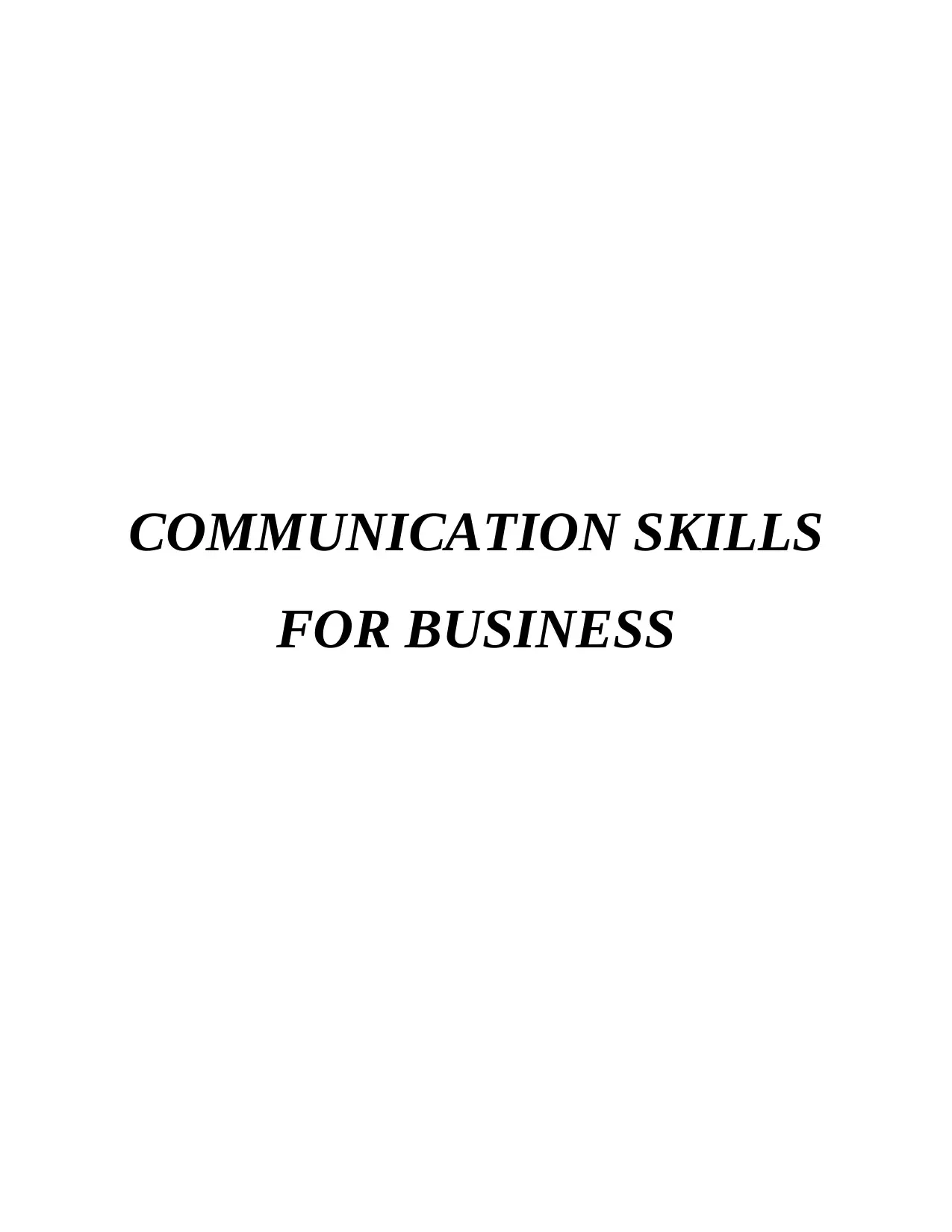
COMMUNICATION SKILLS
FOR BUSINESS
FOR BUSINESS
Paraphrase This Document
Need a fresh take? Get an instant paraphrase of this document with our AI Paraphraser
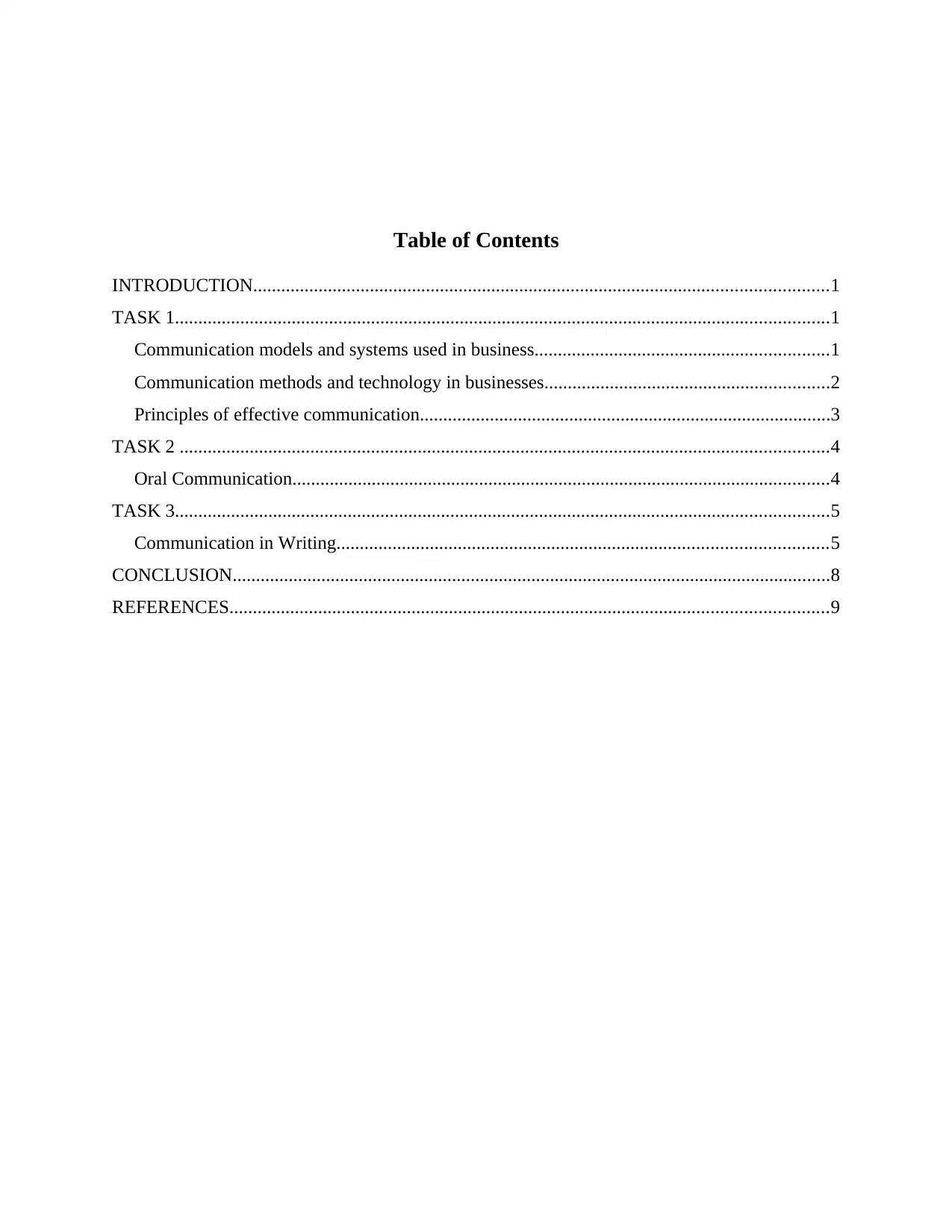
Table of Contents
INTRODUCTION...........................................................................................................................1
TASK 1............................................................................................................................................1
Communication models and systems used in business...............................................................1
Communication methods and technology in businesses.............................................................2
Principles of effective communication........................................................................................3
TASK 2 ...........................................................................................................................................4
Oral Communication...................................................................................................................4
TASK 3............................................................................................................................................5
Communication in Writing.........................................................................................................5
CONCLUSION................................................................................................................................8
REFERENCES................................................................................................................................9
INTRODUCTION...........................................................................................................................1
TASK 1............................................................................................................................................1
Communication models and systems used in business...............................................................1
Communication methods and technology in businesses.............................................................2
Principles of effective communication........................................................................................3
TASK 2 ...........................................................................................................................................4
Oral Communication...................................................................................................................4
TASK 3............................................................................................................................................5
Communication in Writing.........................................................................................................5
CONCLUSION................................................................................................................................8
REFERENCES................................................................................................................................9
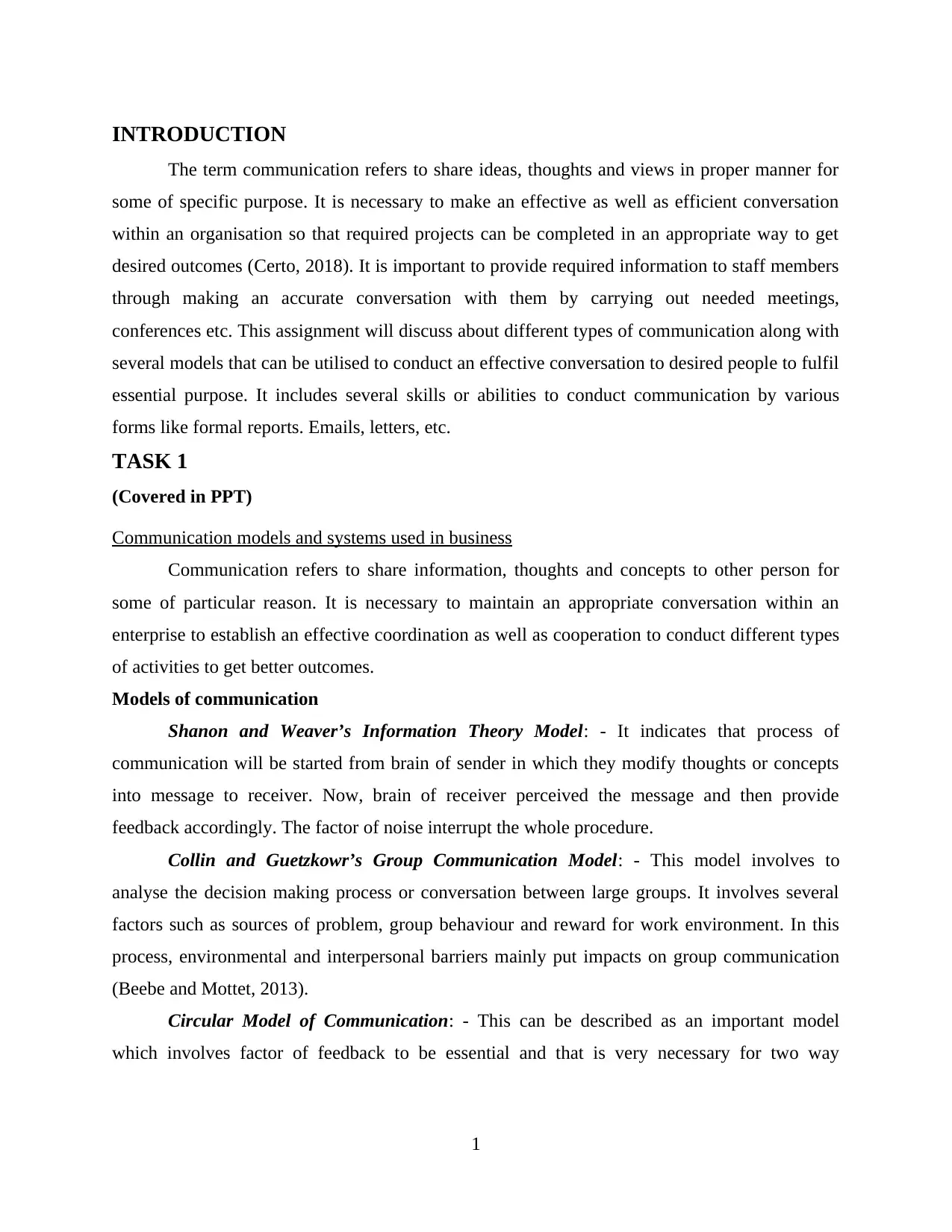
INTRODUCTION
The term communication refers to share ideas, thoughts and views in proper manner for
some of specific purpose. It is necessary to make an effective as well as efficient conversation
within an organisation so that required projects can be completed in an appropriate way to get
desired outcomes (Certo, 2018). It is important to provide required information to staff members
through making an accurate conversation with them by carrying out needed meetings,
conferences etc. This assignment will discuss about different types of communication along with
several models that can be utilised to conduct an effective conversation to desired people to fulfil
essential purpose. It includes several skills or abilities to conduct communication by various
forms like formal reports. Emails, letters, etc.
TASK 1
(Covered in PPT)
Communication models and systems used in business
Communication refers to share information, thoughts and concepts to other person for
some of particular reason. It is necessary to maintain an appropriate conversation within an
enterprise to establish an effective coordination as well as cooperation to conduct different types
of activities to get better outcomes.
Models of communication
Shanon and Weaver’s Information Theory Model: - It indicates that process of
communication will be started from brain of sender in which they modify thoughts or concepts
into message to receiver. Now, brain of receiver perceived the message and then provide
feedback accordingly. The factor of noise interrupt the whole procedure.
Collin and Guetzkowr’s Group Communication Model: - This model involves to
analyse the decision making process or conversation between large groups. It involves several
factors such as sources of problem, group behaviour and reward for work environment. In this
process, environmental and interpersonal barriers mainly put impacts on group communication
(Beebe and Mottet, 2013).
Circular Model of Communication: - This can be described as an important model
which involves factor of feedback to be essential and that is very necessary for two way
1
The term communication refers to share ideas, thoughts and views in proper manner for
some of specific purpose. It is necessary to make an effective as well as efficient conversation
within an organisation so that required projects can be completed in an appropriate way to get
desired outcomes (Certo, 2018). It is important to provide required information to staff members
through making an accurate conversation with them by carrying out needed meetings,
conferences etc. This assignment will discuss about different types of communication along with
several models that can be utilised to conduct an effective conversation to desired people to fulfil
essential purpose. It includes several skills or abilities to conduct communication by various
forms like formal reports. Emails, letters, etc.
TASK 1
(Covered in PPT)
Communication models and systems used in business
Communication refers to share information, thoughts and concepts to other person for
some of particular reason. It is necessary to maintain an appropriate conversation within an
enterprise to establish an effective coordination as well as cooperation to conduct different types
of activities to get better outcomes.
Models of communication
Shanon and Weaver’s Information Theory Model: - It indicates that process of
communication will be started from brain of sender in which they modify thoughts or concepts
into message to receiver. Now, brain of receiver perceived the message and then provide
feedback accordingly. The factor of noise interrupt the whole procedure.
Collin and Guetzkowr’s Group Communication Model: - This model involves to
analyse the decision making process or conversation between large groups. It involves several
factors such as sources of problem, group behaviour and reward for work environment. In this
process, environmental and interpersonal barriers mainly put impacts on group communication
(Beebe and Mottet, 2013).
Circular Model of Communication: - This can be described as an important model
which involves factor of feedback to be essential and that is very necessary for two way
1
⊘ This is a preview!⊘
Do you want full access?
Subscribe today to unlock all pages.

Trusted by 1+ million students worldwide
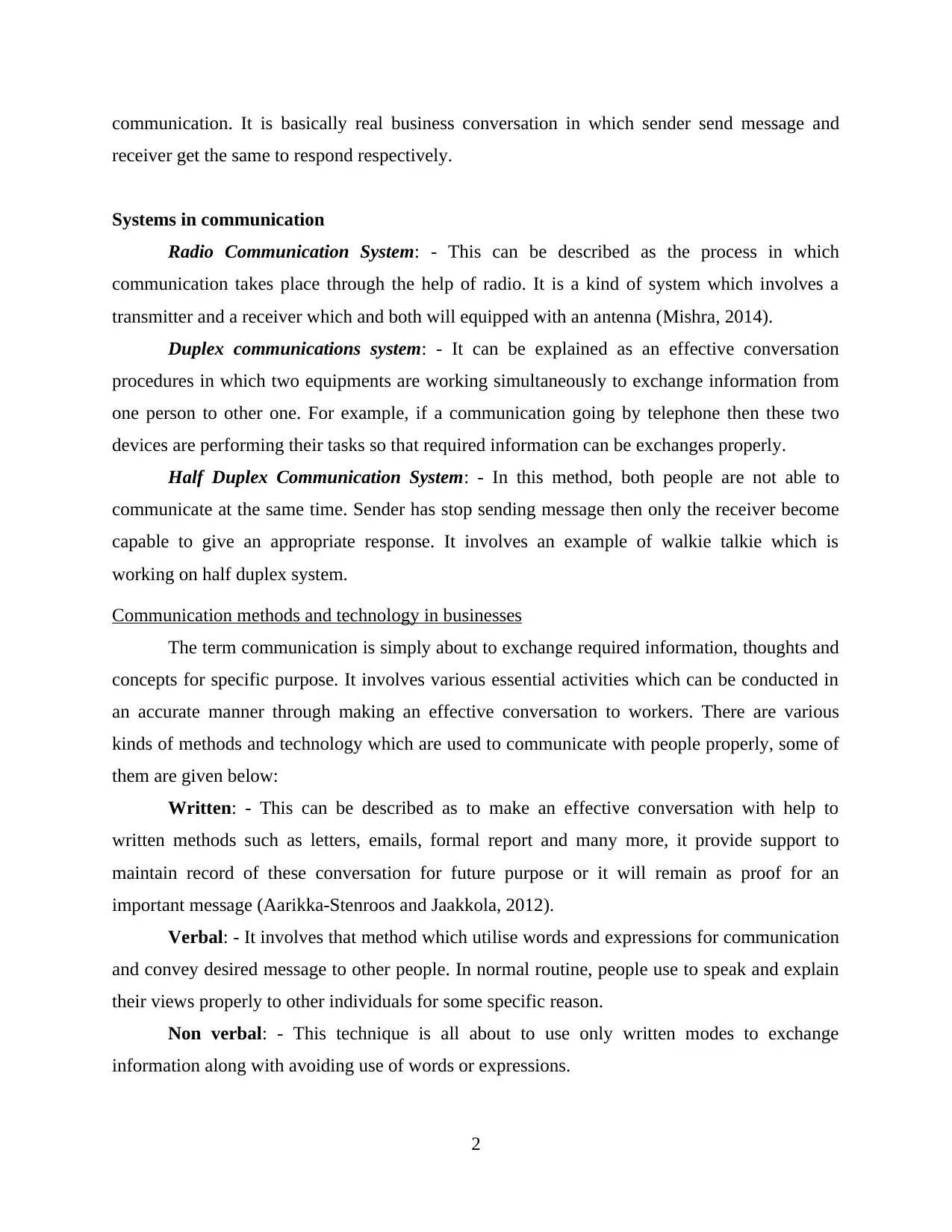
communication. It is basically real business conversation in which sender send message and
receiver get the same to respond respectively.
Systems in communication
Radio Communication System: - This can be described as the process in which
communication takes place through the help of radio. It is a kind of system which involves a
transmitter and a receiver which and both will equipped with an antenna (Mishra, 2014).
Duplex communications system: - It can be explained as an effective conversation
procedures in which two equipments are working simultaneously to exchange information from
one person to other one. For example, if a communication going by telephone then these two
devices are performing their tasks so that required information can be exchanges properly.
Half Duplex Communication System: - In this method, both people are not able to
communicate at the same time. Sender has stop sending message then only the receiver become
capable to give an appropriate response. It involves an example of walkie talkie which is
working on half duplex system.
Communication methods and technology in businesses
The term communication is simply about to exchange required information, thoughts and
concepts for specific purpose. It involves various essential activities which can be conducted in
an accurate manner through making an effective conversation to workers. There are various
kinds of methods and technology which are used to communicate with people properly, some of
them are given below:
Written: - This can be described as to make an effective conversation with help to
written methods such as letters, emails, formal report and many more, it provide support to
maintain record of these conversation for future purpose or it will remain as proof for an
important message (Aarikka-Stenroos and Jaakkola, 2012).
Verbal: - It involves that method which utilise words and expressions for communication
and convey desired message to other people. In normal routine, people use to speak and explain
their views properly to other individuals for some specific reason.
Non verbal: - This technique is all about to use only written modes to exchange
information along with avoiding use of words or expressions.
2
receiver get the same to respond respectively.
Systems in communication
Radio Communication System: - This can be described as the process in which
communication takes place through the help of radio. It is a kind of system which involves a
transmitter and a receiver which and both will equipped with an antenna (Mishra, 2014).
Duplex communications system: - It can be explained as an effective conversation
procedures in which two equipments are working simultaneously to exchange information from
one person to other one. For example, if a communication going by telephone then these two
devices are performing their tasks so that required information can be exchanges properly.
Half Duplex Communication System: - In this method, both people are not able to
communicate at the same time. Sender has stop sending message then only the receiver become
capable to give an appropriate response. It involves an example of walkie talkie which is
working on half duplex system.
Communication methods and technology in businesses
The term communication is simply about to exchange required information, thoughts and
concepts for specific purpose. It involves various essential activities which can be conducted in
an accurate manner through making an effective conversation to workers. There are various
kinds of methods and technology which are used to communicate with people properly, some of
them are given below:
Written: - This can be described as to make an effective conversation with help to
written methods such as letters, emails, formal report and many more, it provide support to
maintain record of these conversation for future purpose or it will remain as proof for an
important message (Aarikka-Stenroos and Jaakkola, 2012).
Verbal: - It involves that method which utilise words and expressions for communication
and convey desired message to other people. In normal routine, people use to speak and explain
their views properly to other individuals for some specific reason.
Non verbal: - This technique is all about to use only written modes to exchange
information along with avoiding use of words or expressions.
2
Paraphrase This Document
Need a fresh take? Get an instant paraphrase of this document with our AI Paraphraser
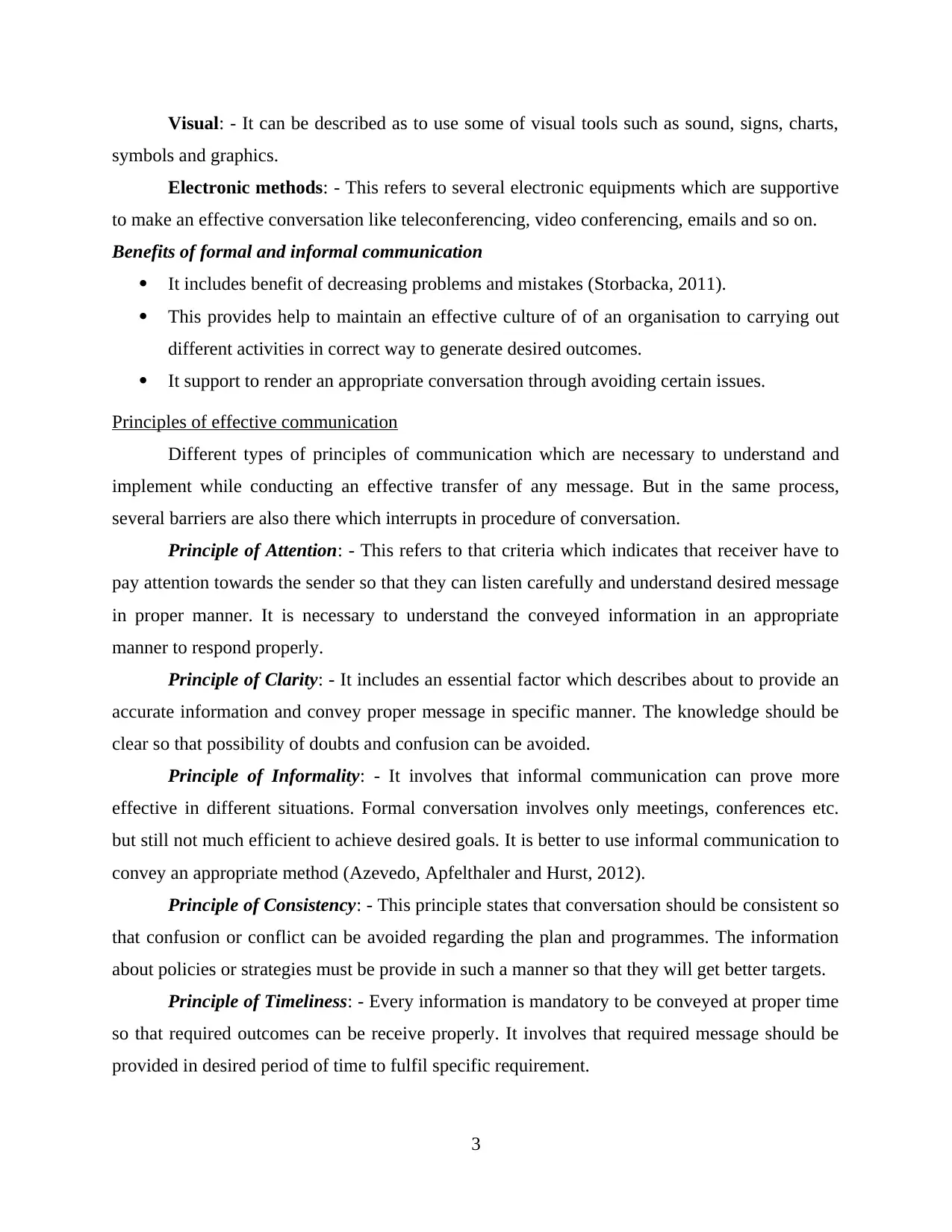
Visual: - It can be described as to use some of visual tools such as sound, signs, charts,
symbols and graphics.
Electronic methods: - This refers to several electronic equipments which are supportive
to make an effective conversation like teleconferencing, video conferencing, emails and so on.
Benefits of formal and informal communication
It includes benefit of decreasing problems and mistakes (Storbacka, 2011).
This provides help to maintain an effective culture of of an organisation to carrying out
different activities in correct way to generate desired outcomes.
It support to render an appropriate conversation through avoiding certain issues.
Principles of effective communication
Different types of principles of communication which are necessary to understand and
implement while conducting an effective transfer of any message. But in the same process,
several barriers are also there which interrupts in procedure of conversation.
Principle of Attention: - This refers to that criteria which indicates that receiver have to
pay attention towards the sender so that they can listen carefully and understand desired message
in proper manner. It is necessary to understand the conveyed information in an appropriate
manner to respond properly.
Principle of Clarity: - It includes an essential factor which describes about to provide an
accurate information and convey proper message in specific manner. The knowledge should be
clear so that possibility of doubts and confusion can be avoided.
Principle of Informality: - It involves that informal communication can prove more
effective in different situations. Formal conversation involves only meetings, conferences etc.
but still not much efficient to achieve desired goals. It is better to use informal communication to
convey an appropriate method (Azevedo, Apfelthaler and Hurst, 2012).
Principle of Consistency: - This principle states that conversation should be consistent so
that confusion or conflict can be avoided regarding the plan and programmes. The information
about policies or strategies must be provide in such a manner so that they will get better targets.
Principle of Timeliness: - Every information is mandatory to be conveyed at proper time
so that required outcomes can be receive properly. It involves that required message should be
provided in desired period of time to fulfil specific requirement.
3
symbols and graphics.
Electronic methods: - This refers to several electronic equipments which are supportive
to make an effective conversation like teleconferencing, video conferencing, emails and so on.
Benefits of formal and informal communication
It includes benefit of decreasing problems and mistakes (Storbacka, 2011).
This provides help to maintain an effective culture of of an organisation to carrying out
different activities in correct way to generate desired outcomes.
It support to render an appropriate conversation through avoiding certain issues.
Principles of effective communication
Different types of principles of communication which are necessary to understand and
implement while conducting an effective transfer of any message. But in the same process,
several barriers are also there which interrupts in procedure of conversation.
Principle of Attention: - This refers to that criteria which indicates that receiver have to
pay attention towards the sender so that they can listen carefully and understand desired message
in proper manner. It is necessary to understand the conveyed information in an appropriate
manner to respond properly.
Principle of Clarity: - It includes an essential factor which describes about to provide an
accurate information and convey proper message in specific manner. The knowledge should be
clear so that possibility of doubts and confusion can be avoided.
Principle of Informality: - It involves that informal communication can prove more
effective in different situations. Formal conversation involves only meetings, conferences etc.
but still not much efficient to achieve desired goals. It is better to use informal communication to
convey an appropriate method (Azevedo, Apfelthaler and Hurst, 2012).
Principle of Consistency: - This principle states that conversation should be consistent so
that confusion or conflict can be avoided regarding the plan and programmes. The information
about policies or strategies must be provide in such a manner so that they will get better targets.
Principle of Timeliness: - Every information is mandatory to be conveyed at proper time
so that required outcomes can be receive properly. It involves that required message should be
provided in desired period of time to fulfil specific requirement.
3
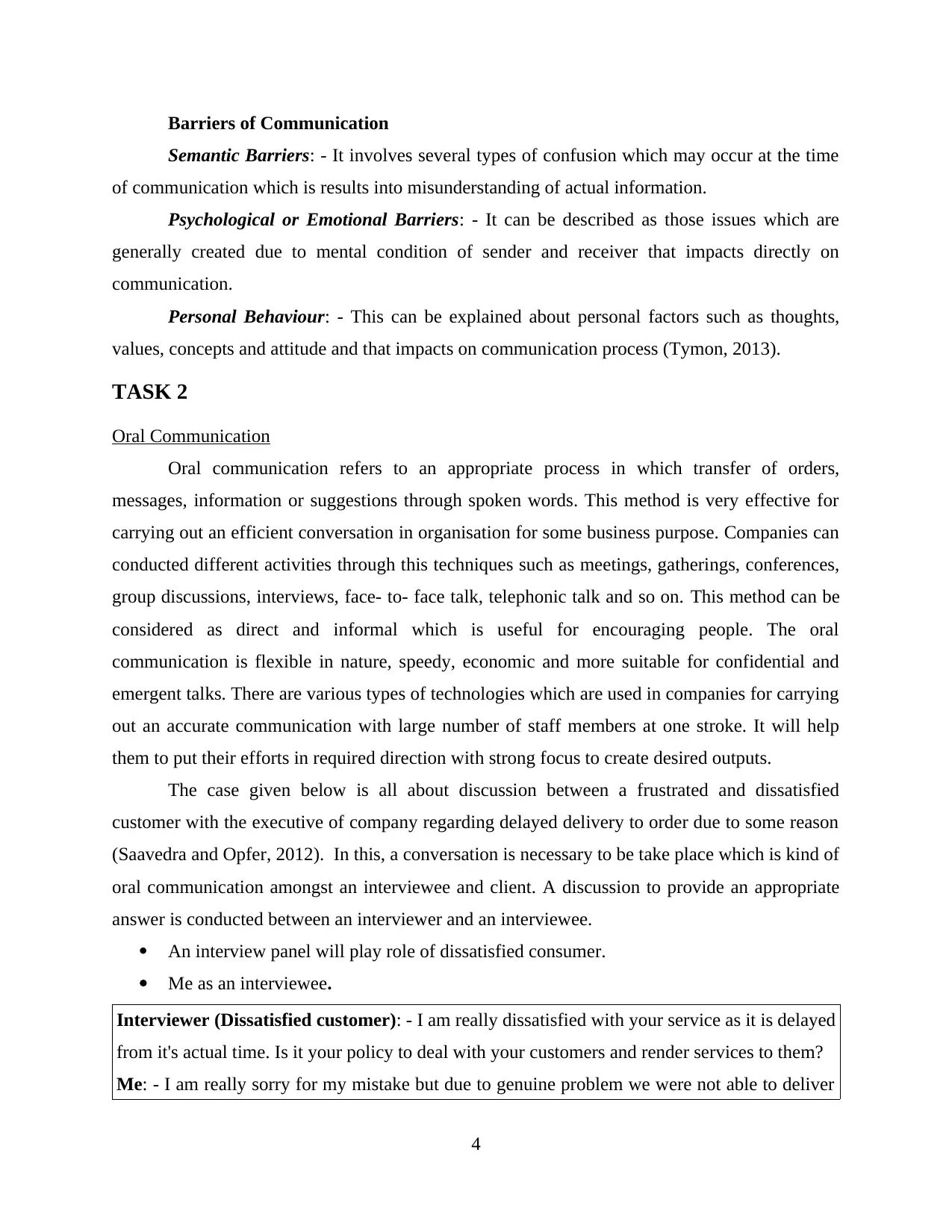
Barriers of Communication
Semantic Barriers: - It involves several types of confusion which may occur at the time
of communication which is results into misunderstanding of actual information.
Psychological or Emotional Barriers: - It can be described as those issues which are
generally created due to mental condition of sender and receiver that impacts directly on
communication.
Personal Behaviour: - This can be explained about personal factors such as thoughts,
values, concepts and attitude and that impacts on communication process (Tymon, 2013).
TASK 2
Oral Communication
Oral communication refers to an appropriate process in which transfer of orders,
messages, information or suggestions through spoken words. This method is very effective for
carrying out an efficient conversation in organisation for some business purpose. Companies can
conducted different activities through this techniques such as meetings, gatherings, conferences,
group discussions, interviews, face- to- face talk, telephonic talk and so on. This method can be
considered as direct and informal which is useful for encouraging people. The oral
communication is flexible in nature, speedy, economic and more suitable for confidential and
emergent talks. There are various types of technologies which are used in companies for carrying
out an accurate communication with large number of staff members at one stroke. It will help
them to put their efforts in required direction with strong focus to create desired outputs.
The case given below is all about discussion between a frustrated and dissatisfied
customer with the executive of company regarding delayed delivery to order due to some reason
(Saavedra and Opfer, 2012). In this, a conversation is necessary to be take place which is kind of
oral communication amongst an interviewee and client. A discussion to provide an appropriate
answer is conducted between an interviewer and an interviewee.
An interview panel will play role of dissatisfied consumer.
Me as an interviewee.
Interviewer (Dissatisfied customer): - I am really dissatisfied with your service as it is delayed
from it's actual time. Is it your policy to deal with your customers and render services to them?
Me: - I am really sorry for my mistake but due to genuine problem we were not able to deliver
4
Semantic Barriers: - It involves several types of confusion which may occur at the time
of communication which is results into misunderstanding of actual information.
Psychological or Emotional Barriers: - It can be described as those issues which are
generally created due to mental condition of sender and receiver that impacts directly on
communication.
Personal Behaviour: - This can be explained about personal factors such as thoughts,
values, concepts and attitude and that impacts on communication process (Tymon, 2013).
TASK 2
Oral Communication
Oral communication refers to an appropriate process in which transfer of orders,
messages, information or suggestions through spoken words. This method is very effective for
carrying out an efficient conversation in organisation for some business purpose. Companies can
conducted different activities through this techniques such as meetings, gatherings, conferences,
group discussions, interviews, face- to- face talk, telephonic talk and so on. This method can be
considered as direct and informal which is useful for encouraging people. The oral
communication is flexible in nature, speedy, economic and more suitable for confidential and
emergent talks. There are various types of technologies which are used in companies for carrying
out an accurate communication with large number of staff members at one stroke. It will help
them to put their efforts in required direction with strong focus to create desired outputs.
The case given below is all about discussion between a frustrated and dissatisfied
customer with the executive of company regarding delayed delivery to order due to some reason
(Saavedra and Opfer, 2012). In this, a conversation is necessary to be take place which is kind of
oral communication amongst an interviewee and client. A discussion to provide an appropriate
answer is conducted between an interviewer and an interviewee.
An interview panel will play role of dissatisfied consumer.
Me as an interviewee.
Interviewer (Dissatisfied customer): - I am really dissatisfied with your service as it is delayed
from it's actual time. Is it your policy to deal with your customers and render services to them?
Me: - I am really sorry for my mistake but due to genuine problem we were not able to deliver
4
⊘ This is a preview!⊘
Do you want full access?
Subscribe today to unlock all pages.

Trusted by 1+ million students worldwide
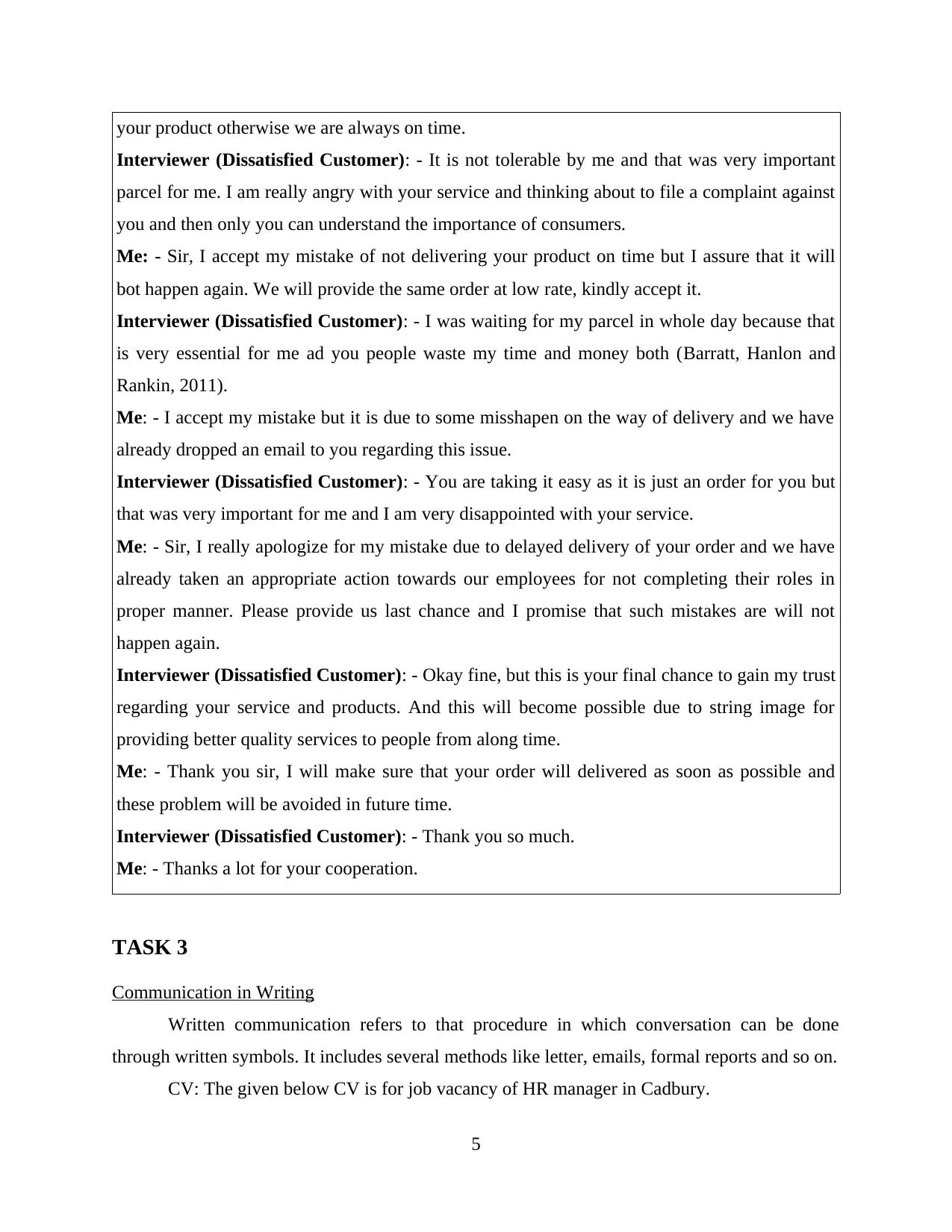
your product otherwise we are always on time.
Interviewer (Dissatisfied Customer): - It is not tolerable by me and that was very important
parcel for me. I am really angry with your service and thinking about to file a complaint against
you and then only you can understand the importance of consumers.
Me: - Sir, I accept my mistake of not delivering your product on time but I assure that it will
bot happen again. We will provide the same order at low rate, kindly accept it.
Interviewer (Dissatisfied Customer): - I was waiting for my parcel in whole day because that
is very essential for me ad you people waste my time and money both (Barratt, Hanlon and
Rankin, 2011).
Me: - I accept my mistake but it is due to some misshapen on the way of delivery and we have
already dropped an email to you regarding this issue.
Interviewer (Dissatisfied Customer): - You are taking it easy as it is just an order for you but
that was very important for me and I am very disappointed with your service.
Me: - Sir, I really apologize for my mistake due to delayed delivery of your order and we have
already taken an appropriate action towards our employees for not completing their roles in
proper manner. Please provide us last chance and I promise that such mistakes are will not
happen again.
Interviewer (Dissatisfied Customer): - Okay fine, but this is your final chance to gain my trust
regarding your service and products. And this will become possible due to string image for
providing better quality services to people from along time.
Me: - Thank you sir, I will make sure that your order will delivered as soon as possible and
these problem will be avoided in future time.
Interviewer (Dissatisfied Customer): - Thank you so much.
Me: - Thanks a lot for your cooperation.
TASK 3
Communication in Writing
Written communication refers to that procedure in which conversation can be done
through written symbols. It includes several methods like letter, emails, formal reports and so on.
CV: The given below CV is for job vacancy of HR manager in Cadbury.
5
Interviewer (Dissatisfied Customer): - It is not tolerable by me and that was very important
parcel for me. I am really angry with your service and thinking about to file a complaint against
you and then only you can understand the importance of consumers.
Me: - Sir, I accept my mistake of not delivering your product on time but I assure that it will
bot happen again. We will provide the same order at low rate, kindly accept it.
Interviewer (Dissatisfied Customer): - I was waiting for my parcel in whole day because that
is very essential for me ad you people waste my time and money both (Barratt, Hanlon and
Rankin, 2011).
Me: - I accept my mistake but it is due to some misshapen on the way of delivery and we have
already dropped an email to you regarding this issue.
Interviewer (Dissatisfied Customer): - You are taking it easy as it is just an order for you but
that was very important for me and I am very disappointed with your service.
Me: - Sir, I really apologize for my mistake due to delayed delivery of your order and we have
already taken an appropriate action towards our employees for not completing their roles in
proper manner. Please provide us last chance and I promise that such mistakes are will not
happen again.
Interviewer (Dissatisfied Customer): - Okay fine, but this is your final chance to gain my trust
regarding your service and products. And this will become possible due to string image for
providing better quality services to people from along time.
Me: - Thank you sir, I will make sure that your order will delivered as soon as possible and
these problem will be avoided in future time.
Interviewer (Dissatisfied Customer): - Thank you so much.
Me: - Thanks a lot for your cooperation.
TASK 3
Communication in Writing
Written communication refers to that procedure in which conversation can be done
through written symbols. It includes several methods like letter, emails, formal reports and so on.
CV: The given below CV is for job vacancy of HR manager in Cadbury.
5
Paraphrase This Document
Need a fresh take? Get an instant paraphrase of this document with our AI Paraphraser
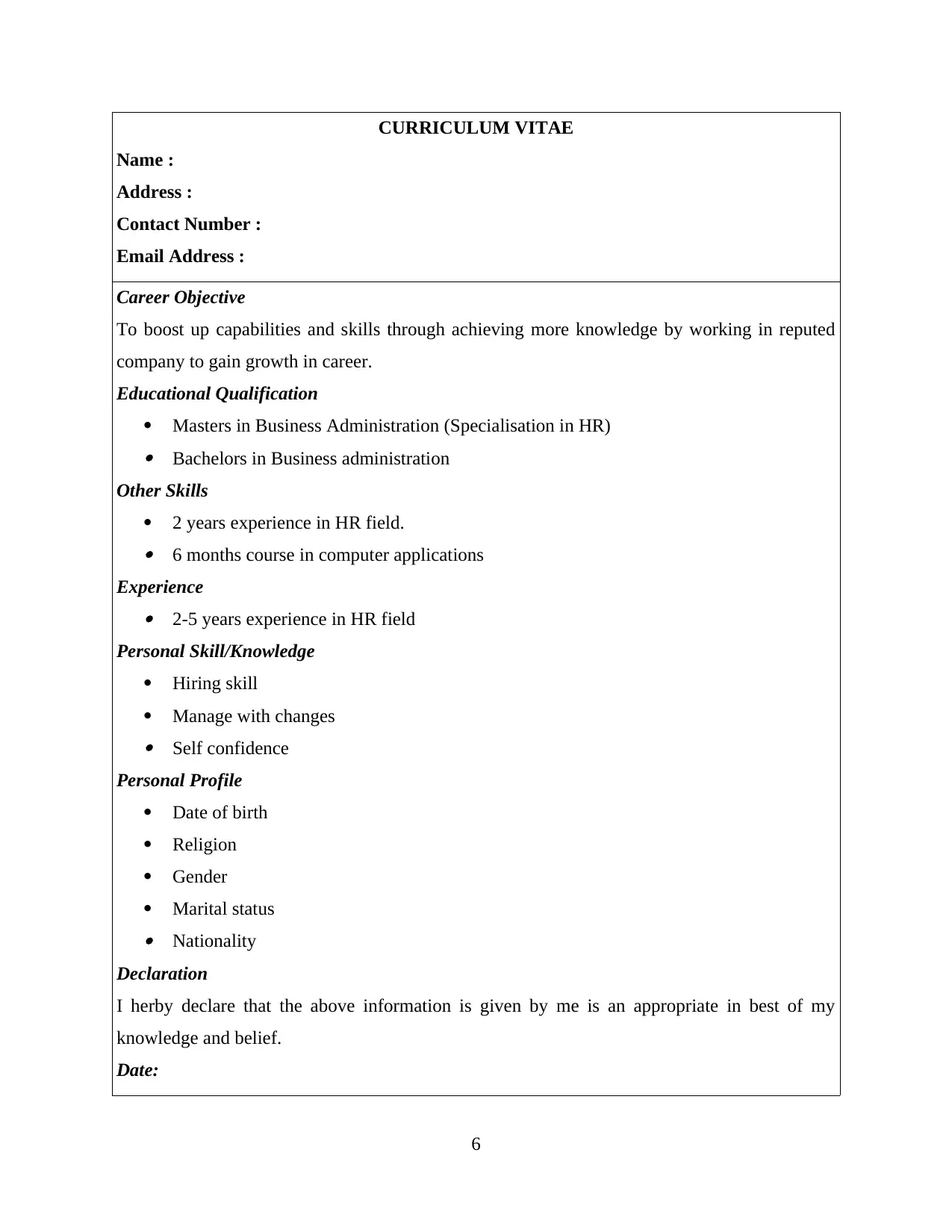
CURRICULUM VITAE
Name :
Address :
Contact Number :
Email Address :
Career Objective
To boost up capabilities and skills through achieving more knowledge by working in reputed
company to gain growth in career.
Educational Qualification
Masters in Business Administration (Specialisation in HR) Bachelors in Business administration
Other Skills
2 years experience in HR field. 6 months course in computer applications
Experience 2-5 years experience in HR field
Personal Skill/Knowledge
Hiring skill
Manage with changes Self confidence
Personal Profile
Date of birth
Religion
Gender
Marital status Nationality
Declaration
I herby declare that the above information is given by me is an appropriate in best of my
knowledge and belief.
Date:
6
Name :
Address :
Contact Number :
Email Address :
Career Objective
To boost up capabilities and skills through achieving more knowledge by working in reputed
company to gain growth in career.
Educational Qualification
Masters in Business Administration (Specialisation in HR) Bachelors in Business administration
Other Skills
2 years experience in HR field. 6 months course in computer applications
Experience 2-5 years experience in HR field
Personal Skill/Knowledge
Hiring skill
Manage with changes Self confidence
Personal Profile
Date of birth
Religion
Gender
Marital status Nationality
Declaration
I herby declare that the above information is given by me is an appropriate in best of my
knowledge and belief.
Date:
6
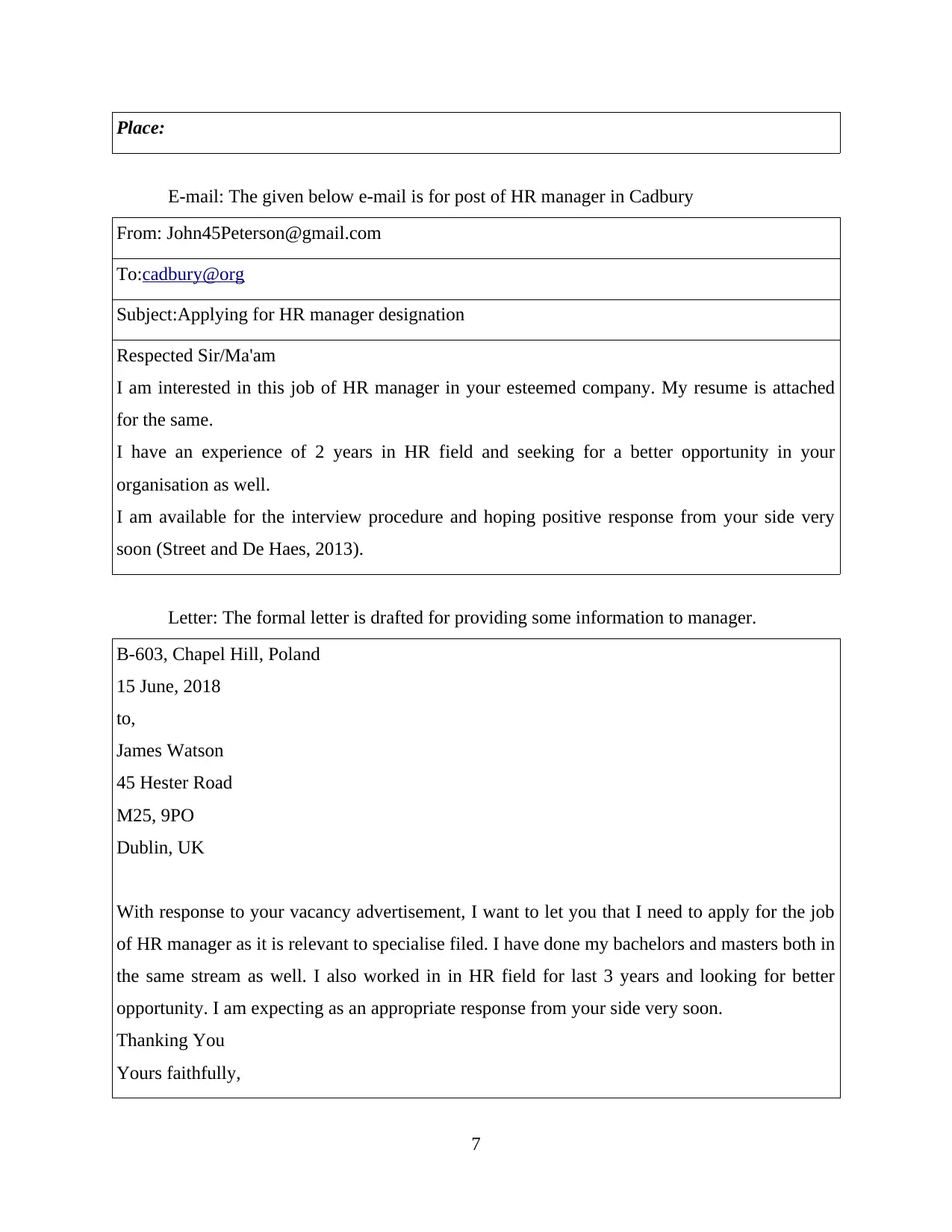
Place:
E-mail: The given below e-mail is for post of HR manager in Cadbury
From: John45Peterson@gmail.com
To:cadbury@org
Subject:Applying for HR manager designation
Respected Sir/Ma'am
I am interested in this job of HR manager in your esteemed company. My resume is attached
for the same.
I have an experience of 2 years in HR field and seeking for a better opportunity in your
organisation as well.
I am available for the interview procedure and hoping positive response from your side very
soon (Street and De Haes, 2013).
Letter: The formal letter is drafted for providing some information to manager.
B-603, Chapel Hill, Poland
15 June, 2018
to,
James Watson
45 Hester Road
M25, 9PO
Dublin, UK
With response to your vacancy advertisement, I want to let you that I need to apply for the job
of HR manager as it is relevant to specialise filed. I have done my bachelors and masters both in
the same stream as well. I also worked in in HR field for last 3 years and looking for better
opportunity. I am expecting as an appropriate response from your side very soon.
Thanking You
Yours faithfully,
7
E-mail: The given below e-mail is for post of HR manager in Cadbury
From: John45Peterson@gmail.com
To:cadbury@org
Subject:Applying for HR manager designation
Respected Sir/Ma'am
I am interested in this job of HR manager in your esteemed company. My resume is attached
for the same.
I have an experience of 2 years in HR field and seeking for a better opportunity in your
organisation as well.
I am available for the interview procedure and hoping positive response from your side very
soon (Street and De Haes, 2013).
Letter: The formal letter is drafted for providing some information to manager.
B-603, Chapel Hill, Poland
15 June, 2018
to,
James Watson
45 Hester Road
M25, 9PO
Dublin, UK
With response to your vacancy advertisement, I want to let you that I need to apply for the job
of HR manager as it is relevant to specialise filed. I have done my bachelors and masters both in
the same stream as well. I also worked in in HR field for last 3 years and looking for better
opportunity. I am expecting as an appropriate response from your side very soon.
Thanking You
Yours faithfully,
7
⊘ This is a preview!⊘
Do you want full access?
Subscribe today to unlock all pages.

Trusted by 1+ million students worldwide
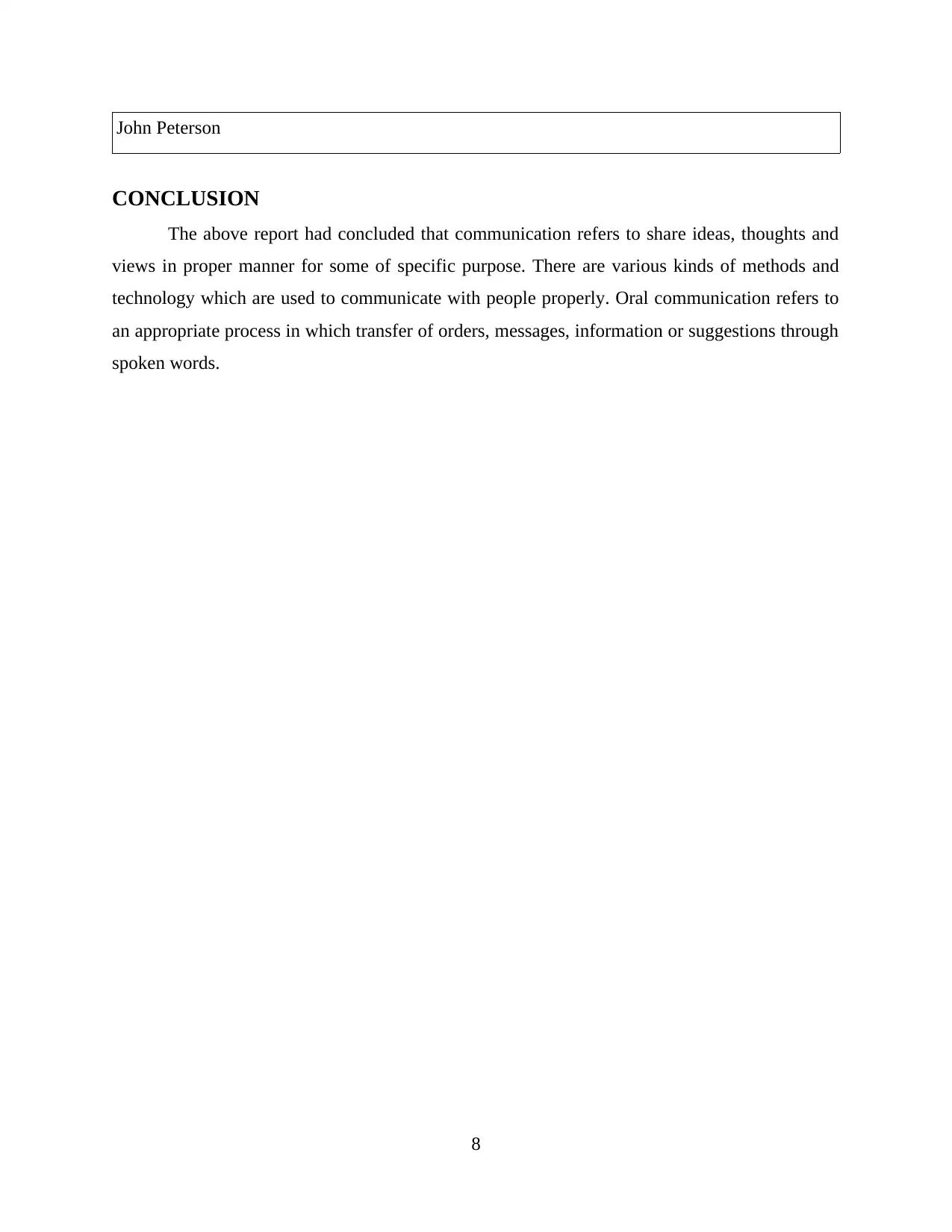
John Peterson
CONCLUSION
The above report had concluded that communication refers to share ideas, thoughts and
views in proper manner for some of specific purpose. There are various kinds of methods and
technology which are used to communicate with people properly. Oral communication refers to
an appropriate process in which transfer of orders, messages, information or suggestions through
spoken words.
8
CONCLUSION
The above report had concluded that communication refers to share ideas, thoughts and
views in proper manner for some of specific purpose. There are various kinds of methods and
technology which are used to communicate with people properly. Oral communication refers to
an appropriate process in which transfer of orders, messages, information or suggestions through
spoken words.
8
Paraphrase This Document
Need a fresh take? Get an instant paraphrase of this document with our AI Paraphraser
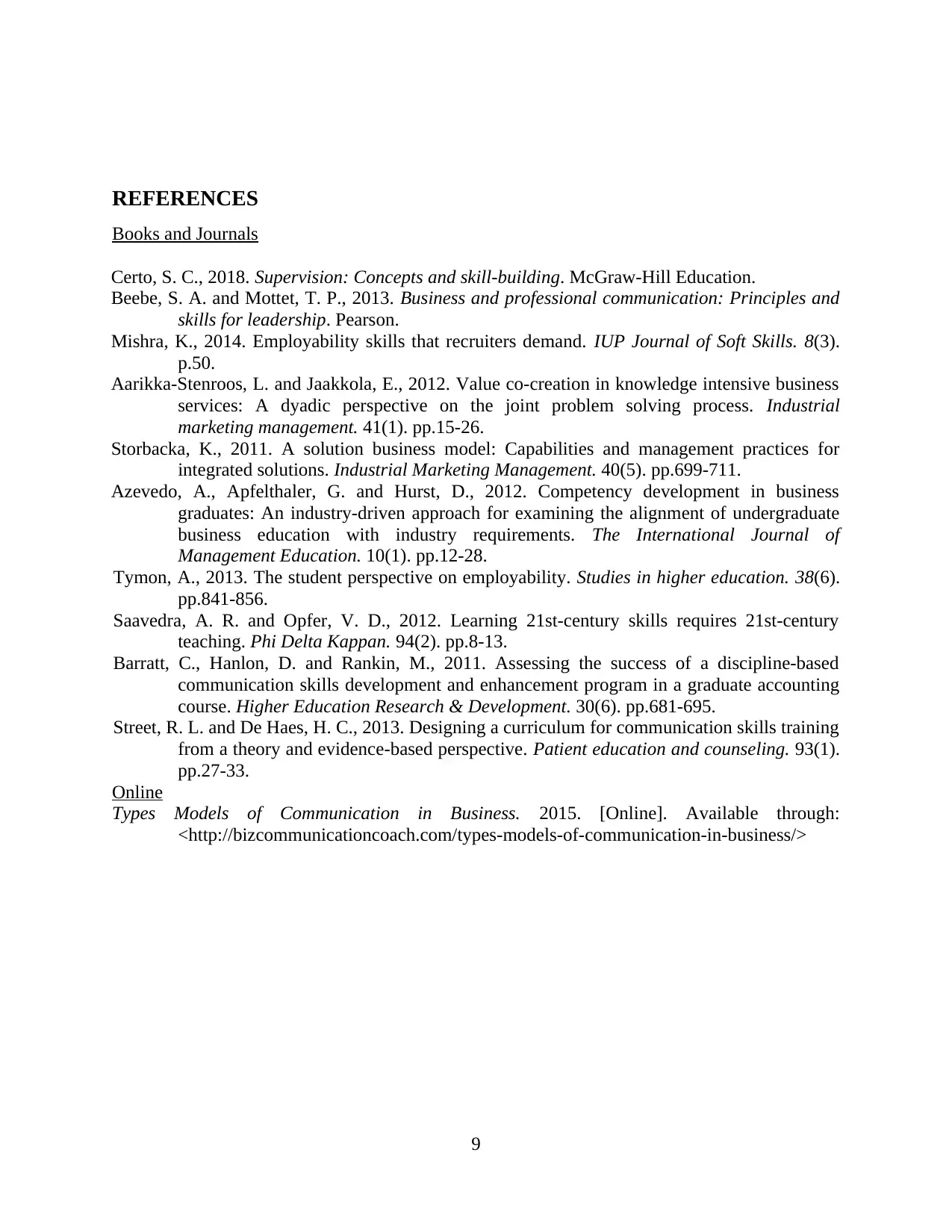
REFERENCES
Books and Journals
Certo, S. C., 2018. Supervision: Concepts and skill-building. McGraw-Hill Education.
Beebe, S. A. and Mottet, T. P., 2013. Business and professional communication: Principles and
skills for leadership. Pearson.
Mishra, K., 2014. Employability skills that recruiters demand. IUP Journal of Soft Skills. 8(3).
p.50.
Aarikka-Stenroos, L. and Jaakkola, E., 2012. Value co-creation in knowledge intensive business
services: A dyadic perspective on the joint problem solving process. Industrial
marketing management. 41(1). pp.15-26.
Storbacka, K., 2011. A solution business model: Capabilities and management practices for
integrated solutions. Industrial Marketing Management. 40(5). pp.699-711.
Azevedo, A., Apfelthaler, G. and Hurst, D., 2012. Competency development in business
graduates: An industry-driven approach for examining the alignment of undergraduate
business education with industry requirements. The International Journal of
Management Education. 10(1). pp.12-28.
Tymon, A., 2013. The student perspective on employability. Studies in higher education. 38(6).
pp.841-856.
Saavedra, A. R. and Opfer, V. D., 2012. Learning 21st-century skills requires 21st-century
teaching. Phi Delta Kappan. 94(2). pp.8-13.
Barratt, C., Hanlon, D. and Rankin, M., 2011. Assessing the success of a discipline-based
communication skills development and enhancement program in a graduate accounting
course. Higher Education Research & Development. 30(6). pp.681-695.
Street, R. L. and De Haes, H. C., 2013. Designing a curriculum for communication skills training
from a theory and evidence-based perspective. Patient education and counseling. 93(1).
pp.27-33.
Online
Types Models of Communication in Business. 2015. [Online]. Available through:
<http://bizcommunicationcoach.com/types-models-of-communication-in-business/>
9
Books and Journals
Certo, S. C., 2018. Supervision: Concepts and skill-building. McGraw-Hill Education.
Beebe, S. A. and Mottet, T. P., 2013. Business and professional communication: Principles and
skills for leadership. Pearson.
Mishra, K., 2014. Employability skills that recruiters demand. IUP Journal of Soft Skills. 8(3).
p.50.
Aarikka-Stenroos, L. and Jaakkola, E., 2012. Value co-creation in knowledge intensive business
services: A dyadic perspective on the joint problem solving process. Industrial
marketing management. 41(1). pp.15-26.
Storbacka, K., 2011. A solution business model: Capabilities and management practices for
integrated solutions. Industrial Marketing Management. 40(5). pp.699-711.
Azevedo, A., Apfelthaler, G. and Hurst, D., 2012. Competency development in business
graduates: An industry-driven approach for examining the alignment of undergraduate
business education with industry requirements. The International Journal of
Management Education. 10(1). pp.12-28.
Tymon, A., 2013. The student perspective on employability. Studies in higher education. 38(6).
pp.841-856.
Saavedra, A. R. and Opfer, V. D., 2012. Learning 21st-century skills requires 21st-century
teaching. Phi Delta Kappan. 94(2). pp.8-13.
Barratt, C., Hanlon, D. and Rankin, M., 2011. Assessing the success of a discipline-based
communication skills development and enhancement program in a graduate accounting
course. Higher Education Research & Development. 30(6). pp.681-695.
Street, R. L. and De Haes, H. C., 2013. Designing a curriculum for communication skills training
from a theory and evidence-based perspective. Patient education and counseling. 93(1).
pp.27-33.
Online
Types Models of Communication in Business. 2015. [Online]. Available through:
<http://bizcommunicationcoach.com/types-models-of-communication-in-business/>
9
1 out of 11
Related Documents
Your All-in-One AI-Powered Toolkit for Academic Success.
+13062052269
info@desklib.com
Available 24*7 on WhatsApp / Email
![[object Object]](/_next/static/media/star-bottom.7253800d.svg)
Unlock your academic potential
Copyright © 2020–2025 A2Z Services. All Rights Reserved. Developed and managed by ZUCOL.





